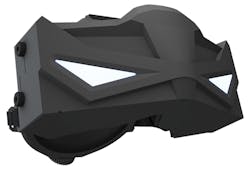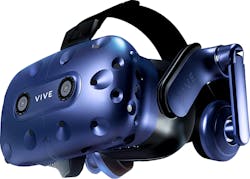The key to virtual reality (VR) is a good headset. A number of challenges crop up, though, including video hardware capable of driving these high-resolution headsets. Luckily, new GPUs like NVIDIA’s Quadro GV100, can now keep up with higher-resolution VR headsets at 90 Hz, the preferred scan rate for VR headsets. Likewise, the GV100 supports NVIDIA’s latest ray-tracing software that provides photorealistic rendering in real time.
Facebook’s Oculus Rift and the HTC Vive delivers 1080- by 1200-pixel resolution per eye. They have a field of view (FOV) of 110 degrees, and feature room-scale support and built-in headphones plus microphone. These platforms work with existing, higher-end video cards and gaming systems. Many have been used for commercial applications, but most target gaming and entertainment.
Commercial and industrial VR applications like industrial design and training systems often demand higher-resolution solutions. This higher resolution is often necessary to deliver a high-enough image quality to allow users to make judgements based on what they see.
Firsthand Experience
Last year at the Consumer Electronics show, I was able to try out Pimax’s 8K virtual-reality headset. It was impressive, but it’s still not available yet. Pimax’s headset has a whopping 3840 by 2160 pixels per eye. It also has a 200-deg. FOV. The view from inside the headset was impressive, although the GPU hardware was more limited at that time.
1. Vrgineers’ VRHero 5K Plus targets commercial applications such as industrial design and training.
I also tested out some of the latest hi-res VR headsets, which are available now, at this year’s NVIDIA GPU Technology Conference. The Vrgineers VRHero 5K Plus (Fig. 1) has a 170-deg. FOV with a per-eye resolution of 2560 by 1440 pixels. Twice that gives the 5K resolution highlighted in the product’s name. The custom optics use clear, non-Fresnel lenses to view the OLED displays. It has a 70-Hz refresh rate. The demo I viewed was a rendition of a car where I could examine the detail of the surfaces and dashboard display.
“The disruptive potential of virtual reality in the enterprise is immense. VRgineers’ professional headsets powered by the new Quadro GV100 GPU means, for the first time, professionals in industries such as product design, architecture, and engineering can conduct realistic simulations where high resolution and overall image quality are key,” said Bob Pette, Vice President, Professional Visualization, NVIDIA.
Marek Polcak, Vrgineers co-founder and CEO, said, “With the new NVIDIA Quadro GV100, driven by the NVIDIA Volta GPU architecture, our VR Hero 5K enterprise clients will be able to run larger and more sophisticated 3D scenes, use near production-quality models without the need for tedious manual optimization, and enable performance-demanding functions, such as particle simulations or antialiasing, in VR. I believe this will dramatically reduce the number of hours invested into the content adaptation and streamline the process for VR in industrial applications.”
The VRHero 5K Plus supports a wide range of tracking systems. It also has a built-in Leap Motion sensor that can track the user’s hands, allowing for operation in many VR applications without the need for hand controllers. Of course, users can have better control and additional inputs using hand controllers.
The other hi-res VR headset on display at GTC 2018 was the HTC Vive Pro. It was used in a number of exhibits, including the NVIDIA Holodeck where multiple users could work collaboratively from remote locations. Attendees were also able to use the Vive Pro to enter the “Ready Player One Escape Room.” Users had to solve a series of puzzles to escape the basement within 10 minutes.
2. HTC Vive Pro delivers 2880 by 1600 pixels per eye. It also supports the Lighthouse 2.0 laser tracking system.
The Vive Pro ups the resolution of the Vive from 2160 by 1200 pixels to 2880 by 1600 pixels using an AMOLED display (Fig. 2). Both versions have a refresh rate of 90 Hz with a 110-deg. FOV. The Vive Pro has an increased tracking area of 33 by 33 feet. Furthermore, it switches from HDMI to DisplayPort 1.2. Of course, the minimum GPU configuration is higher for the Vive Pro. On top of that, there’s a pair of front-facing cameras and support for the new Lighthouse 2.0 laser tracking system.
The Vive Pro also has an optional wireless module and takes advantage of Intel’s WiGig wireless technology. Its dual-microphone system allows for better active noise cancellation.
Though we’re still in the infancy of VR, the technology is ready for prime time. The technology will continue to improve, but it can now handle more-demanding applications from architectural and automotive designs to healthcare.




